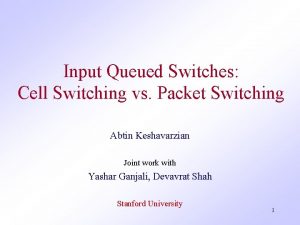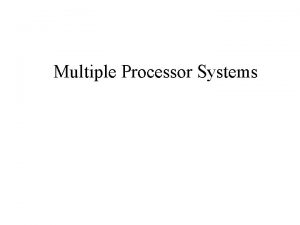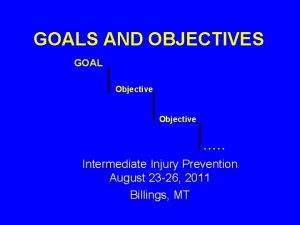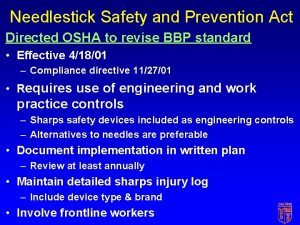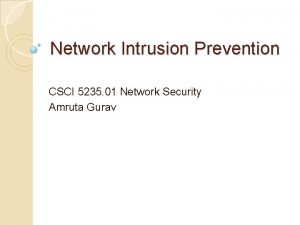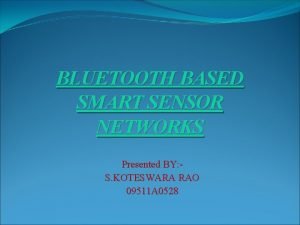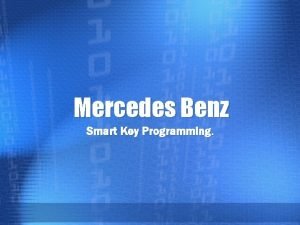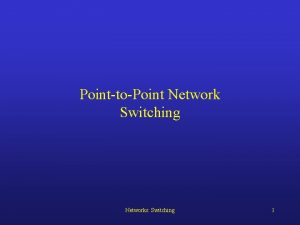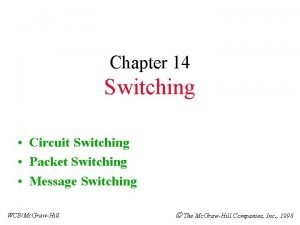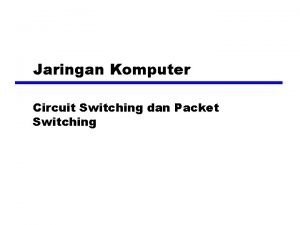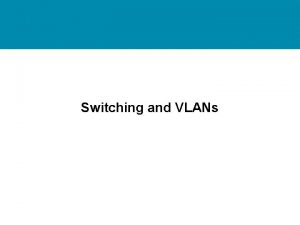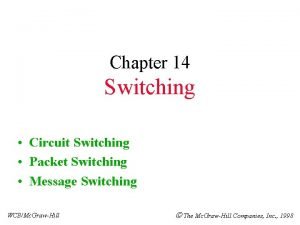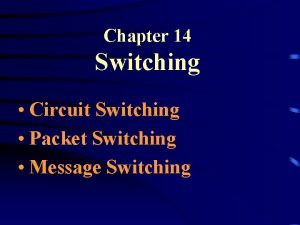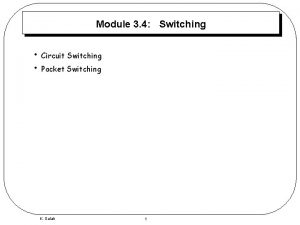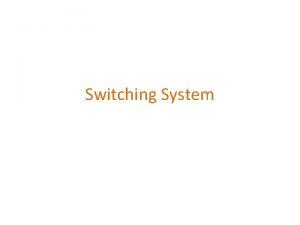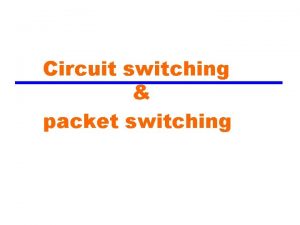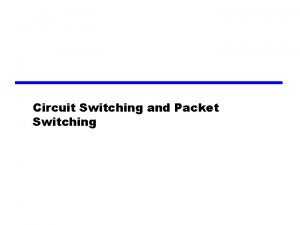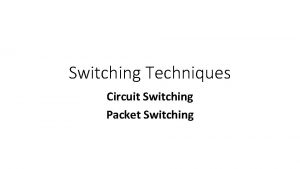Safety Through Prevention Safe Switching Using Smart Key










































- Slides: 42

Safety Through Prevention – Safe Switching Using Smart Key Technology LOGO Nan Liu Shuqiang Jin, Unitech, Zhuhai, China Youru Huang, SERCC EPRI's 14 th Annual Power Switching Safety & Reliability Conference San Diego, California September 20~21, 2010

Contents • Switching Errors and Impacts • Traditional Prevention Approaches • Smart Interlock System (SIS) Technology • Development/Application of SIS in China

Impacts of switching errors: • Supply interruptions • Equipment damages • Human losses • Legal liabilities • …

Switching errors can be caused by: Human Error Other …… Inadequate Process Equipment Failure

Common switching error types: 1. Energizing when still grounded. 2. Closing grounding switch when energized. 3. De-energizing using disconnects instead of breakers. 4. Load dropping using disconnects instead of breakers. 5. Entering energized switching bays. q Correct switching sequence is the key.

Preventative Measures: n. Process/Regulation: Strict regulation and process control in all aspects of electric utility operations: design, construction, operation, personnel training and certification. Switching order is the center piece that safeguards safe switching n. Technology: Locks and interlocking devices – mechanical/electromagnetic/electrical/programmed. Rule/topology based automated switching order generation.

Conventional locks and interlocks They work to certain extent but have limitations ØLack of comprehensiveness ØLack of flexibility and scalability ØConstrained by complexity ØLack of coordination between multiple switching within same station ………

Preventative measure attributes 1. Reliable 2. Flexible and scalable 3. Comprehensive solution to all the 5 common types of switching errors. 4. Capable of verifying switching steps before switching. 5. Ensures that correct switching steps are followed during switching. 6. Easy to use and simple to install.

Smart Interlock System (SIS) • Developed by Unitech in 1987 (Mr. Jin Shuqiang) • Rule/logic and configuration/topology based solution. • Programmable to suit any voltage levels and station sizes. • Have developed vast rules base and data base capable to accurately model complex real world situations. • One smart key for one station • Simulate switching to prevent switching errors. • Enhanced by the latest computing and communication technologies

Smart Interlock System (SIS) SCADA Workstation/Software Smart Key Locks

Smart interlock System (SIS) Process Switching Order Open Lock §Simulate switching step on the workstation. §Switching order generation. §Transferring steps to smart key. §Perform switching steps. §Return smart key to workstation with status updates.

Logic/Rules/Configuration Databases • Collect and model switching interlock logic and rules • Collect and model single line diagram of station/system • Logic/rules for each bay as well as interbay dependency in a station. Status Database Logic Database

Software/Model Interaction • Two databases are stored in a workstation. • The software works with models to display user interface. Status Database Human Interface Logic Database Work station

Smart Key – Only Need One for Each Station n n Works with both electronic and mechanical locks Capable of multiple wireless communication protocols § Ir. DA § Zigbee § CDMA/GPRS Programmable RFID locks. Voice reminder/recorder Ambient temperature -40℃ to 80℃

Locks Embedded with RFID technology Programmed to work with the smart key

SIS Operation Cycle - Simulation Transfer Allowed? Logic Database Status Database Switching Completion

SIS Operation Cycle - Transfer Simulation Transfer Switching Completion

SIS Operation Cycle - Switching Simulation Transfer Switching Completion

SIS Operation Cycle - Completion Simulation Transfer Switching Completion

Example: Energize the Line Bus Disconnect #1 Breaker Disconnect #2

STEP 1: Pre-switching Simulation Switching sequence Bus Disconnect #1 1. Close Disconnect #1 2. Close Disconnect #2 Breaker Disconnect #2 3. Close Breaker Error

STEP 2: Transfer Switching Instructions to Smart Key Bus Disconnect #1 Breaker 1. Close Disconnect #1 2. Close Disconnect #2 3. Close Breaker

STEP 3: Perform Switching Bus Disconnect #1 Breaker Disconnect #2 1. Close Disconnect #1 2. Close Disconnect #2 3. Close Breaker

STEP 3: Perform Switching Bus Disconnect #1 Breaker Disconnect #2 1. Close Disconnect #1 2. Close Disconnect #2 3. Close Breaker

STEP 3: Perform Switching Bus Disconnect #1 Breaker Disconnect #2 1. Close Disconnect #1 2. Close Disconnect #2 3. Close Breaker

STEP 4: Switching complete-Steps saved Bus Disconnect #1 Breaker Disconnect #2

Performing switching The unique programmed electronic ID in each RFID equipped locks ensures that only the corresponding smart key can open it. This virtually eliminates opening/closing the wrong disconnects or breakers.

SIS Benefits: Simulation before switching identifies and eliminates potential errors SIS Conventional Switching Approach Order Switching Order Simulation Switching Verification Switching

SIS Benefits: Multi-switching bay switching coordination Based on safe switching logic/rules 111 -2 h: 111=0, 111 -1 d=0, 111 -2 d=0, 1111 w=0, 111 -7=0, 111 -3=1! 111 -2 l: 111=0, 111 -1 d=0, 111 -2 d=0, 1111 w=0, 111 -7=0, 111 -3=1! 111 -3 h: 111=0, 111 -1 d=0, 111 -2 d=0, 1111 w=0, 3 -7=0, 111 -2=0! 111 -3 l: 111=0, 111 -1 d=0, 111 -2 d=0, 1111 w=0, 3 -7=0, 111 -2=0!

SIS Benefits: One key per station: easy to program and upgrade. Many keys Smart Key

SIS Benefits: Standardized locks. Easy to manage and to maintain

SIS Benefits: Reliable, flexible, easy to use. For stations of any voltage levels and bus types and setups.

30+ years of SIS development and application Mr Jin Shuqiang pioneered the SIS technology in 1987. Since then, Unitech Zhuhai and other companies in China continue to research and innovate in the area of safe switching technology.

SIS Deployment in China Over 22, 00 sites with SIS in 2005

SIS Deployment in China (cont. ) The number of switching error related incidents dropped significantly

Interlocking Applications

Three Gorge Project

Shanghai World Expo 500 k. V Substation

1000 k. V Substation

Conclusion • Smart Interlocking System (SIS) is proven reliable technology that prevents switching errors. • SIS has significantly reduced accidents and losses related caused by human errors in China. • We look forward to deploying SIS technology to customers in the United States and other parts of world.

Q&A Questions??

Safety Through Prevention – Safe Switching Using Smart Key Technology LOGO Nan Liu Shuqiang Jin, Unitech, Zhuhai, China Youru Huang, SERCC EPRI's 14 th Annual Power Switching Safety & Reliability Conference San Diego, California September 20~21, 2010 en. ut. com. cn
 Circuit switching vs packet switching vs message switching
Circuit switching vs packet switching vs message switching Primary prevention secondary prevention tertiary prevention
Primary prevention secondary prevention tertiary prevention Virtual circuit network
Virtual circuit network Cell switching vs packet switching
Cell switching vs packet switching Distinguish between circuit switching and packet switching
Distinguish between circuit switching and packet switching Each packet is treated independently
Each packet is treated independently Cell switching vs packet switching
Cell switching vs packet switching Safe feed safe food
Safe feed safe food Safe people safe places
Safe people safe places Uma multiprocessors using multistage switching networks
Uma multiprocessors using multistage switching networks Examples of smart goals for fall prevention
Examples of smart goals for fall prevention Safe and smart physical activity
Safe and smart physical activity Chapter 2 classroom activity 2-2
Chapter 2 classroom activity 2-2 Injury prevention safety and first aid
Injury prevention safety and first aid Osha needlestick protocol
Osha needlestick protocol Fire hose reel signage standards
Fire hose reel signage standards Configure ios intrusion prevention system (ips) using cli
Configure ios intrusion prevention system (ips) using cli Safe start behavior based safety
Safe start behavior based safety Street smart vs book smart
Street smart vs book smart One smart man he felt smart
One smart man he felt smart Interserf
Interserf Answers to everfi smart shopping
Answers to everfi smart shopping It's not how smart you are
It's not how smart you are Street smart vs book smart quotes
Street smart vs book smart quotes Street smart vs book smart quotes
Street smart vs book smart quotes One smart man he felt smart
One smart man he felt smart A savings option many employers offer is
A savings option many employers offer is Glencoe health chapter 3
Glencoe health chapter 3 Cost structure example business model canvas
Cost structure example business model canvas Business model canvas tripadvisor
Business model canvas tripadvisor What are three possible exiting problems
What are three possible exiting problems Safe plates module 1 answer key
Safe plates module 1 answer key Be smart.ie
Be smart.ie Smart sensor networks using bluetooth
Smart sensor networks using bluetooth Smart card type meter
Smart card type meter By one man sin
By one man sin Furcation involvement classification
Furcation involvement classification Advantages and disadvantages of tangential sawing
Advantages and disadvantages of tangential sawing The night of scorpion poem
The night of scorpion poem Mbkeyonline
Mbkeyonline Safety depth formula in ecdis
Safety depth formula in ecdis Safety care certification
Safety care certification Personal safety vs process safety
Personal safety vs process safety



